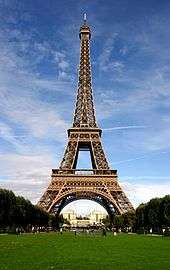Tourist attraction

A tourist attraction is a place of interest where tourists visit, typically for its inherent or exhibited natural or cultural value, historical significance, natural or built beauty, offering leisure, adventure and amusement.
Types

Natural beauty such as beaches, tropical island resorts with coral reefs, hiking and camping in national parks, mountains and forests, are examples of traditional tourist attractions to spend summer vacations. Other examples of cultural tourist attractions include historical places, monuments, ancient temples, zoos, aquaria, museums and art galleries, botanical gardens, buildings and structures (e.g., castles, libraries, former prisons, skyscrapers, bridges), theme parks and carnivals, living history museums, ethnic enclave communities, historic trains and cultural events. Factory tours, industrial heritage, creative art and crafts workshops are the object of cultural niches like industrial tourism and creative tourism. Many tourist attractions are also landmarks.
Tourist attractions are also created to capitalise on legends such as a supposed UFO crash site near Roswell, New Mexico and the alleged Loch Ness monster sightings in Scotland. Ghost sightings also make tourist attractions.
Ethnic communities may become tourist attractions, such as Chinatowns in the United States and the black British neighbourhood of Brixton in London, England.
In the United States, owners and marketers of attractions advertise tourist attractions on billboards along the side of highways and roadways, especially in remote areas. Tourist attractions often provide free promotional brochures and flyers in information centres, fast food restaurants, hotel and motel rooms or lobbies, and rest area.
While some tourist attractions provide visitors a memorable experience for a reasonable admission charge or even for free, others can have a tendency to be of low quality and to overprice their goods and services (such as admission, food, and souvenirs) in order to profit from tourists excessively. Such places are commonly known as tourist traps.
Within cities such transport tourist attractions as rides by boats and buses (City Sightseeing, etc.) are very popular .
Novelty attraction
Novelty attractions are oddities such as the "biggest ball of twine" in Cawker City, Kansas, the Corn Palace in Mitchell, South Dakota, or Carhenge in Alliance, Nebraska, where old cars serve in the place of stones in a replica of Stonehenge. Novelty attractions are not limited to the American Midwest, but are part of Midwestern culture.[1]
Tourist destination

There is currently no widely accepted definition of the term tourist destination.[2][3] From the tourism industry supply perspective a destination is usually defined by a geo-political boundary, given destination marketing is most commonly funded by governments.[4] From the traveler perspective, a destination might be perceived quite differently.
A tourist destination is a city, town, or other area that is dependent to a significant extent on the revenues accruing from tourism, or "a country, state, region, city, or town which is marketed or markets itself as a place for tourists to visit".[5] It may contain one or more tourist attractions and possibly some "tourist traps." Siem Reap town for example is a popular tourist destination in Cambodia, mainly owed to its proximity to Angkor temples.
A tropical island resort is an island or archipelago that also depends on tourism as its source of revenue. The Bahamas in Caribbean archipelago, Bali in Indonesia, Phuket in Thailand, Hawaii in the United States, Palawan in the Philippines, and Fiji in the Pacific, Vamizi Island, Santorini and Ibiza in Mediterranean are examples of popular island resorts.
Economic Impact
The tourism industry generates substantial economic benefits to both host countries and tourists home countries. Especially in developing countries, one of the primary motivations for a region to promote itself as a tourism destination is the expected economic improvement. According to the World Tourism Organization, 698 million people travelled to a foreign country in 2000, spending more than US$478 billion. International tourism receipts combined with passenger transport currently total more than US$575 billion - making tourism the worlds number one export earner, ahead of automotive products, chemicals, petroleum and food.[6]
Tourist attractions can:
- Contribute to government revenues, direct contributions are generated by taxes on incomes from tourism employment and tourism businesses, and by direct levies on tourists such as departure taxes.
- Provide employment.
- Stimulate infrastructure investment.
- Contribute to local economies.
- Provide foreign exchange earnings.
See also
Notes
- ↑ "A Golden Gate Fantasy on the Kansas Prairie" article by A.G. Suleberger in The New York Times September 15, 2010, accessed September 16, 2010
- ↑ Pike, Steven; Page, Stephen (2014). "Destination marketing organizations and destination marketing: A narrative analysis of the literature.". Tourism Management. 41: 202–207. doi:10.1016/j.tourman.2013.09.009.
- ↑ Saraniemi, S; Kylanen, M (2011). "Problemizing the concept of tourist destination: An anlysis of different theoretical approaches.". Journal of Travel Research. 50 (2): 133.
- ↑ Pike, Steven (2016). Destination Marketing Essentials (Second ed.). Oxford: Routledge. ISBN 978-1-138-91290-8.
- ↑ Beirman, David (2003). Restoring Tourism Destinations in Crisis: A Strategic Marketing Approach. CABI Publishing.
- ↑ "Economic impact of tourism". 2012-07-12.
External links
| Wikimedia Commons has media related to Visitor attractions. |
| Wikivoyage has a travel guide for Attractions. |
- Attractions at DMOZ